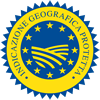Description
The Uva da Tavola di Canicattì PGI refers to the fresh table grape belonging to the Italia variety of the species Vitis vinifera L., known as “Pirovano 65”, which is obtained from the hybridisation of Bicane with Moscato d’Amburgo.
Production Area
The production area of Uva da Tavola di Canicattì PGI is within a few municipalities in the provinces of Agrigento and Caltanissetta, in the Sicily region.
Production Method
The “pergola” high-training system is used, with arches from 2.80 x 2.80 metres up to 3 metres and a density of 1100 plants per hectare. A series of “green procedures” must be carried out before the bunches are fully ripe: pruning, organic-mineral fertilisation, removal of the buds, de-leaving, straightening the bunches. “Green” interventions serve to integrate and complete winter pruning, with the aim of maintaining a balance between the plant’s vegetative stage and reproductive stage. The vines are thinned and selected in order to improve the quality of the product and the conformation of the bunches. Emergency irrigation is carried out when necessary, due to the excessive dryness of the production area. The vines are covered with special material in order to guarantee the conservation of the grapes on the plant: this extends the seasonality of the fruit and therefore harvesting can be carried out over a particularly long period of time, starting during the second ten days of August and finishing during the first ten days of January. A total unit production of 25,000 kg of grapes per hectare is permitted.
Appearance and Flavour
Uva da Tavola di Canicattì PGI has sparse even-coloured bunches, with a medium-large size and a conic-pyramidal shape. They have evenly developed stalks and a woody peduncle. The grapes are medium-large with a spherical-elliptic shape. The pulp is dense and crunchy, ranging from pale yellow to golden straw-yellow in colour, with a sweet flavour and a delicate Muscat aroma.
History
Up until the mid-19th century there was no distinction between table grapes and grapes for wine making. The differentiation was officially sanctioned in Italy in 1887, when the government was asked to create an ad hoc law to valorise wine grapes in respect to table grapes. The cultivation of the Italia variety started in the mid-20th century and it was named so in honour of the Unification of Italy. Agronomist Alberto Pirovano created this variety at the beginning of the 20th century, by hybridising the Bicane grape variety with Moscato d’Amburgo; the new variety found the ideal micro-climate in the area of Canicattì. However, it only became an established cultivation at the beginning of the 1960s, becoming a substitute for the traditional crops of cereal, almonds and legumes.
Gastronomy
Uva da Tavola di Canicattì PGI keeps for over a month if kept at low temperatures. To benefit from this fruit’s disinfecting, antiviral, diuretic and laxative properties, it should be eaten in the morning, on an empty stomach. In cooking it can be used as an ingredient in cakes, jams, marmalades and juices, but it is also delicious in savoury dishes, especially those with pork.
Marketing
The product is marketed as Uva da Tavola di Canicattì PGI. It is sold from the second ten days of August to the first ten days of January, in chests or containers with a minimum capacity of 500 g.
Distinctive Features
The colour and crunchiness of Uva di Canicattì PGI are given to the high concentration of calcium in the soil of the production area. The climatic characteristics of the region also make it possible for the grapes to remain on the vine until the beginning of January, which guarantees that the product is always fresh.






















